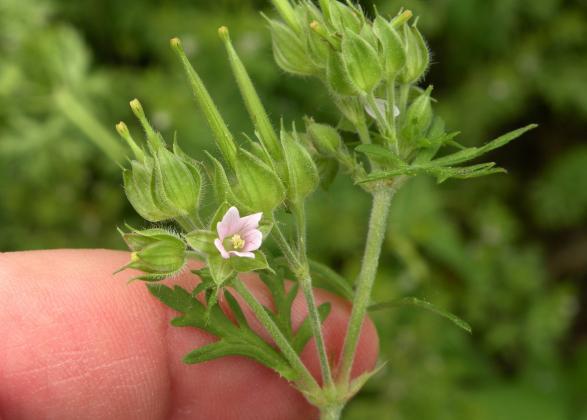Geranium carolinianum - Helps some crops, hinders others
Geranium carolinianum, cranesbill or Carolina geranium, is a cool season North American native. It can be annual or biennial, taking two years to complete its lifecycle. It has pink to red erect to semi-erect stems that are 8 to 16 inches tall. Fine hairs cover the whole plant except for the flowers. The deeply dissected leaves are palmate, shaped like the palm of a hand and may be opposite or alternate. There is sometimes a deep red to brown trim along their edge. In southeast Texas, leaves are seen in early to mid-winter. Pieces of the stem and leaves mixed in soil control some organisms that are harmful to certain crops.
The pale pink flowers, often clustered, bloom from March to May. They have five petals each with dark veins and a rounded notch at the end. They are less than ½ inch across, mostly pollinated by small bees. The pointy green sepals that enclose the flower are almost as long as the petals. The flowers produce brown and violet dyes.
The 1-inch fruits, seedpods, are 5-lobed capsules, each lobe with one seed. Their resemblance to a crane’s beak is what gives the plant its common name. The “beak” turns black when ripe. As it dries, it acts like a catapult when it splits open lengthwise flinging seeds several feet from the plant.
Cranesbill’s taproot is about 2 inches deep. It’s the part most sought after in traditional medicine although the leaves are also used. Roots are usually harvested just before flowering. The whole plant is edible raw or cooked although it’s bitter because it contains tannins. It is an antioxidant, astringent, anti-fungal and anti-inflammatory. It treats wounds and skin conditions, diarrhea, sore throat, digestive issues, arthritis, etc. Following is an article from the National Institutes of Health, ncbi.nlm.nih.gov.
• “Anti-hepatitis B virus activities of Geranium carolinianum L. extracts and identification of the active components”.
Two articles from the U.S. Department of Agriculture, usda.gov are below.
• “Identification and activity of ethyl gallate as an antimicrobial compound produced by Geranium carolinianum”.
• “Control of soil rot of sweet potato by the incorporation of the fresh aerial tissue of Geranium carolinianum L. into the soil”.
The agriculture industry uses the gas methyl bromide to control pests in the field and shipping. It is being phased out because it damages Earth’s ozone layer. Cranesbill is one target of a relatively new technology, convolutional neural networks, CNNs. CNNs analyze images to detect small differences in areas that are near each other. In a strawberry crop that is harmed by cranesbill growing in it, CNNs can differentiate between the two leaf shapes that are a fraction of an inch apart or touching or overlapping. A chemical control can spot-treat the cranesbill without contaminating the strawberry plant. It can do this from a height of about 3 to 4 feet. In addition to agriculture, CNN applications include detecting X-ray and magnetic resonance imaging (MRI) anomalies, facial recognition, gaming, etc.
Deborah Richardson is a freelance reporter for The Examiner with a fondness for flora in its natural setting.




